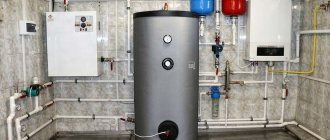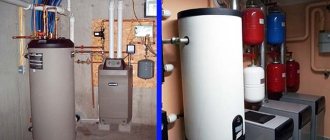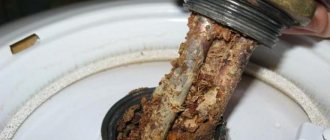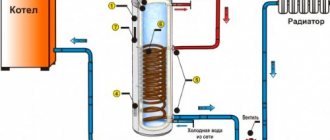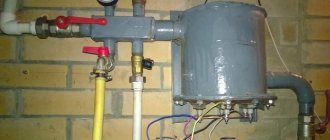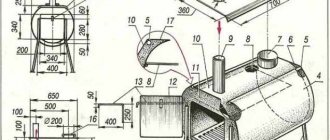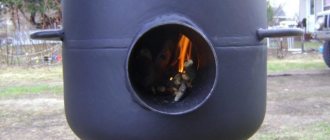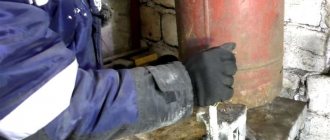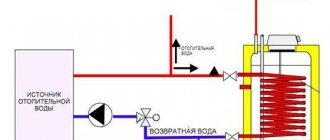What is an indirect heating boiler
An indirect heating boiler is a water heating tank that operates in conjunction with central heating devices . Unlike traditional water heaters, an indirect type boiler does not require connection to the electrical network.
Indirect heating boilers may have different designs, but they all heat water using the energy of the boiler coolant
Heating of water occurs due to heat exchange between hot water flowing through the heat exchanger and cold water with which the boiler tank is filled. Externally, the boiler is a cylindrical container with a capacity of tens to several thousand liters.
Indirect water heaters are used both in private houses, the owners of which do not have the ability to connect to an autonomous centralized heating system, and in large industries where large amounts of hot water are required.
Advantages and disadvantages of indirect heating equipment
Among the advantages of an indirect type boiler are:
- profitability (no energy costs);
- high equipment performance, limited only by the power of the heating boiler;
- lack of direct contact between running water and coolant;
- the ability to consume thermal energy from several sources at once to increase the power and efficiency of the boiler.
Significant disadvantages of the equipment include:
- high cost. An indirect heating boiler costs 1.5–2 times more than a direct type water heater;
- insufficient power. Heating a large amount of water (more than 100 liters) may require quite a lot of time - from 1 hour. Some manufacturers offer boilers with a higher heating rate (30–35 minutes), but their cost is unreasonably high;
- large dimensions. The size of the equipment directly depends on the volume of the tank. Boilers with a capacity of over 200 liters take up too much space, so they are installed in a separate utility room;
- impossibility of year-round use. Effective operation only during the heating season (autumn - winter). In summer, when the heating boiler is turned off, the water in the boiler does not heat up.
An indirect heating boiler takes longer to prepare hot water, but it does not require an electrical connection
Video: experience using an indirect type boiler
Reviews
According to the owners of indirect heating boilers, this device is the most convenient and efficient of all water heaters.
Of course, they install it mainly when there is excessive heating in the house.
The tank, theoretically designed for 2 – 4 people, fully covers the needs for hot water even when guests arrive.
If the tank is well insulated, users notice that it maintains a good water temperature for 35 hours, which allows saving money even during summer periods of using the heating element.
Breakdowns occur mainly due to careless operation of the entire system. For example, when the antifreeze in the heating has not been changed for many years, or if poor-quality seams were made during manufacturing.
So. An indirect heating boiler will quickly pay for itself due to its high operating efficiency. It works both as a heater and as a thermos. At the same time, it has a simple design, which allows you to build the device yourself.
Warm floors have many advantages; ease of installation stands out among others. Electric heated floors – how to choose the best? Cable, film, rod floors - read the overview of all systems and choose your option.
Read about how to choose an electric heating boiler in this block.
Design features of an indirect boiler
The indirect type boiler is a tank made of stainless steel. The inner walls of the container are covered with a special material, which not only protects the surface of the water heater from corrosion processes, but also reduces the concentration of harmful bacteria and microorganisms.
Diagram of an indirect type boiler with a single-circuit coil
Otherwise, a boiler of the simplest design consists of the following components:
- heat exchanger - a spiral pipe or smaller tank. Depending on the volume of the tank, it can be located in its upper and lower parts;
- inlet pipe - a fitting at the bottom of the device for supplying a pipe with cold running water;
- outlet pipe - fitting for connecting the hot water outlet pipe;
- magnesium anode - additional protection of the tank walls from corrosion processes;
- internal thermometer - a device for measuring the temperature of heating water;
- thermostat - a device that prevents equipment from overheating;
- control unit - rotary knob with divisions for setting the heating temperature;
- thermal insulation - a layer of insulating material that helps maintain the desired temperature of the heated water;
- outlet - valve for draining stagnant water;
- revision - a large diameter hole intended for maintenance, repair and modernization of the boiler.
The design of new tank models may differ slightly and have a number of modifications from manufacturers, but in general, any indirect type boiler consists of the listed elements.
Operating principle of the boiler
An indirect type boiler is part of the heating system and is connected directly to a gas, electric or solid fuel boiler, which heats the coolant using the energy released when fuel is burned.
The coolant circulates through the DHW system and passes through a heat exchanger located in the indirect heating boiler. Due to the release of thermal energy from the hot coolant, the cold water that fills the device’s tank is heated. From it, heated water is transported through an outlet through a pipe to the bathroom, kitchen and other rooms with plumbing equipment.
An indirect type boiler can work with any type of heating boiler
When the heating boiler is turned off or switched to an economical operating mode, the coolant quickly cools down. Thanks to the design of insulating the tank walls with urethane foam, the water in the tank cools very slowly. This allows you to use the entire volume of warm water for several more hours.
Calculation of the main parameters of the boiler
Before you begin searching for material and directly manufacturing, you will need to calculate the minimum volume of the tank and the working length of the heat exchanger.
Volume and shape of the tank
The volume of the water tank directly depends on the number of residents permanently residing at the place where the equipment is installed. It is believed that a person uses up to 80 liters of water per day. For the calculated value, it is recommended to take 45–50 liters per person. If the norm is exceeded, the water in the tank will stagnate, which will certainly affect its quality.
The shape of the tank is selected taking into account the pressure in the plumbing system. If the pressure is low, then the use of homemade boilers with a square tank is allowed . If the pressure in the system is high, only equipment with a rounded bottom and top can be used.
Boilers with a storage tank of square and rectangular shape can only be used in water supply systems with low operating pressure
The fact is that increased pressure contributes to the occurrence of bending forces on the walls of the tank, so a square or rectangular tank can become deformed. A container with a round bottom is more resistant to deformation due to better streamlining.
Heat exchanger power and length
In vertical indirect heating models, a copper coil is usually used as a heat exchanger, located between the inlet and outlet.
Boiler coil made of copper pipe
For DIY production, it is best to use a copper pipe with a diameter of 10 mm. This product can be easily bent by hand without using any tools. When using a metal-plastic pipe, it should be taken into account that the heating temperature of the coolant should not be more than 90 °C, otherwise the pipe will be deformed and the joints will leak - this will lead to mixing of water in the tank.
The length of the pipe required for the manufacture of the coil is calculated by the formula L = P / (3.14 ∙d ∙∆T), where:
- L—pipe length (m);
- d—pipe cross-section (m);
- ∆Т – temperature difference between heated and cold water (оC);
- P is the power of the heat exchanger for every 10 liters of water (kW).
According to experts, for every 10 liters of water there should be at least 1.5 kW of thermal energy. Taking this into account, you can calculate the length of the pipe for making the coil.
For example, let’s calculate the material for a coil that will be installed in a boiler with a capacity of 200 liters. The temperature of cold water supplied to the container will be 15 oC, and after heating it is necessary to obtain water with a temperature of 80 oC: L = 1.5 ∙20 / (3.14 ∙0.01 ∙65) ≈ 15 m.
Table: length of copper heat exchanger for boilers with a capacity of 50–200 liters
| Storage tank volume, l | Equipment power, kW | Heat exchanger length, m | Boiler tank diameter, m | Coil diameter, m | Number of turns |
| 200 | 30 | 15 | 0,5 | 0,4 | 12 |
| 150 | 22,5 | 11 | 0,5 | 0,4 | 9 |
| 100 | 15 | 7,5 | 0,4 | 0,3 | 8 |
| 50 | 7,5 | 4 | 0,4 | 0,3 | 5 |
The number of turns of the coil depends on the method of bending and the distance between the elements. Typically, the coil is positioned so that the distance between the coils and the walls of the tank is at least 10–12 cm. The distance between the coils should not be less than 5 cm. The calculated values for storage tanks of various volumes can be seen in the table above.
If an indirect type boiler needs to be equipped with a tubular electric heater, then the power is calculated based on the fact that to quickly heat 50 liters of water, a heating element with a power of at least 1.5 kW is required. In addition, any combi boiler must be equipped with a thermostat.
Materials and parts required for the manufacture of a boiler
First of all, you need to select a container for making the tank. The best material choice is stainless steel. You can use a ready-made barrel, order a tank of the required size, or purchase a gas cylinder. It has sufficient strength, suitable dimensions and shape. Another option for making a tank could be a container made of heat-resistant plastic.
Holes of the required size should be made in the tank. Two holes will be needed to connect the cold water supply and hot water supply pipes. One of them is done at the bottom of the tank, and the other at the top of it. Two more holes will be needed for the installation of a coil intended for the passage of coolant.
A tube made of brass or copper is perfect for making a coil These materials transfer heat well and can be easily shaped into the desired shape. You can also use small diameter plastic pipes.
In order to make a coil, a pipe of the required length is wound on a base, which can be a strong metal pipe or a rounded log.
In order for the tube intended for the coil to be bent evenly, without creases, it is completely filled with sand before starting work. Then the coil will be of the correct shape, with the same diameter along its entire length.
Often, novice craftsmen do not know how to correctly calculate the dimensions of the coil. Its parameters depend on several factors - you should take into account the volume of the container, the material of the coil and the temperature of the coolant. It is believed that for every 10 liters of water volume, 1.5 kW of thermal power is required for heating . Based on the volume of the tank, the temperature of the coolant and the temperature of the incoming water, the required length of the coil is calculated. To do this, use a special calculation formula. For a container with a volume of 200 liters, when using a coil with a diameter of 10 mm, its length will be about 15 meters .
Even before installing the storage boiler, you should decide how its thermal insulation will be carried out. It will not be possible to do without it, since natural heat losses are high and the efficiency of the water heater will be too low. The ideal way to insulate a tank is to place it inside a suitable container and then fill it with foam.
To assemble the boiler, you should ensure that you have fittings, nuts, rubber seals, and ball valves. When making a structure from a gas cylinder, welding equipment will be required.
Watch a video on how to make an indirect heating boiler with your own hands:
Read here about the types of wells and wells, as well as the technologies for drilling them with your own hands. How to remove iron from well water? Review of filters and water quality standards.
How to choose a suitable pumping station for a private home? https://klimatlab.com/vodosnabzhenie/vodoprovod/nasosnye-stancii-dlya-chastnogo-doma.html Let’s look at the link.
Required materials and tools
The storage tank of the device is made of heat-resistant plastic, stainless steel, aluminum or ceramic-coated steel. As blanks for the tank, you can take plastic barrels for food products, aluminum tanks or an unnecessary gas cylinder.
To make a heat exchanger, as mentioned above, it is better to use a round or square copper pipe. When assembling a heat exchanger from square pipes, 90° bends will be required.
As a tool you need to prepare:
- angle grinder;
- electric drill with core drill for metal;
- argon-arc welding machine;
- set of wrenches;
- disc for grinding and polishing metal;
- sandpaper.
To assemble the boiler you will need the ability to work with a welding machine.
Fittings, drain valve and other connecting elements are selected based on the size of the connected pipe. Additionally, FUM tape, a safety valve, a magnesium anode and a nozzle for its installation are purchased.
Preparing the tank for water heater assembly
To make an indirect type boiler, you can use a new or old gas cylinder. This container is made of thick stainless steel 3-4 mm thick and is perfect for working with hot water.
Before assembling the heating structure, you will need to carefully prepare the cylinder. To do this, the product is cut in half using a grinder. The inner surface of the container is cleaned using an angle grinder with an appropriate attachment.
Before assembling the boiler, the cylinder must be opened and the inner surface cleaned
After this, the inside of the cylinder is washed, dried and coated with nitro primer paint. This work must be carried out without fail, otherwise after putting the boiler into operation, the heated water will smell like gas.
When using a tank from other metal containers, preparation is carried out according to a similar scheme.
Indirect heating boiler piping
To connect an indirect type boiler, three working schemes are used:
- Trim with three-way valve.
- Connection to two circulation pumps.
- Tying using a hydraulic arrow.
Trim with three-way valve
The piping scheme using a three-way valve is used most often, especially when consuming a large amount of hot water. To do this, two heating circuits are installed in the system. The first is the main circuit used for heating rooms. The second is intended for heating water in the boiler.
The piping diagram for an indirect heating boiler with a three-way valve is most often used
To uniformly distribute and regulate the volume of coolant entering the boiler, a three-way valve is used, which is connected to the thermostat.
The principle of operation of the system is quite simple: if the temperature in the storage tank drops below the set value, the valve redirects part of the coolant to heat the water in the boiler. After heating the water, the coolant returns back to the heating circuit.
Piping with two circulation pumps
An indirect type water heater is installed in a system with two circuits: boiler and heating. A recirculation pump is used to regulate each individual circuit. In this case, the pump on the boiler circuit is mounted in front of the heating equipment pump.
In the piping scheme with circulation pumps, the supply of coolant to the boiler is automatically regulated
Both pumps are connected to the boiler thermostat. When the water in the boiler cools, the thermostat turns on the corresponding pump, which redirects part of the flow from the heating and vice versa.
Tying using a hydraulic arrow
Piping using a hydraulic separator is used in central heating systems consisting of two or more circuits. If in a system without a hydraulic switch, the redistribution of flows in the circuits necessarily affects the operation of any equipment, then when it is installed, a smooth redistribution of cold and hot flows occurs.
The boiler piping scheme with the installation of a hydraulic separator ensures the smoothest distribution of cold and hot water flows
For example, a hydraulic separator must be installed in private houses, where a heated floor system is connected to the central heating in addition to an indirect heating boiler. The design of this harness is quite complex to implement, especially with a large amount of equipment. Therefore, it is better to entrust the installation work to specialists.
Coolant recirculation system
This piping scheme is used when it is necessary to minimize the rate of heating of water in the boiler, since with frequent downtime, the water in the tank quickly cools down, and it takes from 30 to 60 minutes to reheat it.
To do this, a “return” to the water heater is installed in the pipeline running from the boiler to the water tap. A circulation pump connected to a thermostat is also installed in this area.
When the water in the pipeline stagnates and cools, the thermostat turns on the pump, which redirects the cooled water back to heating. When the water supply is restored, the user will not have to wait for it to heat up, since it will already be warm.
Video on the topic
Even residents of apartment buildings equipped with a centralized hot water supply system face the problem of lack of hot water.
If the owners of private houses did not take care of installing a double-circuit boiler that provides the cottage with both heat and hot water, then they begin to look for a way to obtain a sufficient amount of heated water for household needs.
Features of operating an indirect boiler
For proper functioning, the boiler must be installed on a flat, solid surface. When installing a wall-mounted boiler, appropriate fasteners are used that are designed for the weight of the device filled with water.
A tank with a capacity of up to 100 l is mounted on dowel-nails 100 mm long, and for equipment with a capacity of 150–200 l you need to use fasteners up to 150 mm long. It is advisable to hang the boiler on walls made of concrete or brick.
On the line supplying cold water, a check valve must be installed in front of the boiler, which will prevent hot water from entering the cold circuit.
The indirect heating boiler is connected to the system through a check valve
The main problem when operating indirect type boilers is the formation of scale inside the storage tank and heat exchanger when water is heated above 80 °C. Therefore, with moderate consumption of hot water (washing dishes), it is advisable to reduce the temperature to a comfortable 40–50 °C. This will significantly extend the life of the equipment.
Boiler cleaning and repair
If the boiler is used frequently, the tank must be cleaned once a year. To do this, a concentrated solution of citric or acetic acid is pumped into the tank and heated to a temperature of 80–90 oC. After 20–30 minutes, the liquid is drained. If the heating system uses a coolant in the form of ordinary water, then for preventive purposes the heat exchanger is cleaned according to a similar scheme.
If a leak appears at the pipe connection, it is necessary to disassemble the problem area and reinstall it using more sealant. Instead of sanitary flax, more modern materials should be used, for example, FUM tape or sanitary thread.
Installation procedure
Installation of an indirect heating boiler, in which the coolant is supplied through a coil, begins with its installation. A thread is cut at the ends of the coil, onto which a lock nut is screwed, and then they are inserted into the prepared holes in the tank so that the lock nuts have a stop.
The threaded part of the coil should extend beyond the surface of the tank. Rubber gaskets are put on them, and threaded couplings are screwed on top of them. As a result of these manipulations, the coil is securely fixed, and it becomes possible to connect it to the heating system.
The next stage of work is to connect the tank to cold water and drain the hot water tap to the required location. The final part of the installation will be insulating the water heater, but before that you should check the tightness of all connections.
This way you can provide your home with enough hot water at minimal cost. The cost of purchased materials will cost a small amount, especially if you compare it with industrially manufactured models. The price of a factory-made boiler starts from 20 thousand rubles for models from Drazice OKC.
Video on how to properly connect an indirect heating boiler with your own hands:
